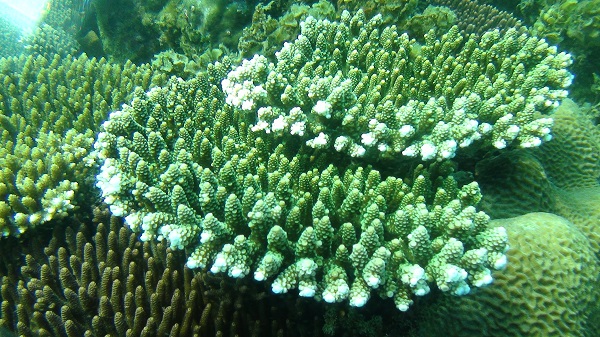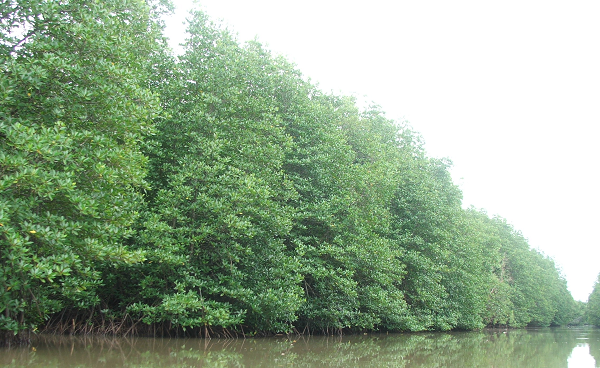 |
Coral reef ecosystem
Coral reef ecosystem
The total area of coral reefs in Vietnam’s coastal waters is estimated at 13,426 ha (Nguyen Van Hieu, Do Van Khuong, 2013), of which the area with the largest coral reef area includes Phu Quy islands (1,858 ha), Ly Son (1,704 ha), Bach Long Vi (1,578 ha), Van Phong bay (1,618 ha) (Nguyen Van Long, 2015); and coastal areas Ninh Hai - Ninh Thuan (2,330 ha) (Vo Si Tuan, 2014). In the waters of the Truong Sa archipelago, Nam Yet island has an area of about 250 hectares of coral reefs, about 4,500 hectares of Thuyen Chai, and about 210 hectares of Da Nam island.
There are about 444 coral species distributed in the islands in Vietnam’s sea, in which there are about 378 species off hard coral and 66 species of soft coral (Do Van Khuong et al., 2016); There are about 1,206 species of coral reef fish in the sea of Vietnam ( Nguyen Nhat Thi, Nguyen Van Quan, 2005), of which 514 species of coral reef fish in 10 areas are planned to establish marine protected areas (Do Van Khuong et al., 2008); There are about 6,377 benthic species have been listed, 1,064 species have not been published and 667 species have not been identified.
Mangroves ecosystem
The total area of mangroves in our country was about 214,081 ha in 2011-2012 (Trinh Van Hanh, 2014). According to statistics of the Ministry of Agriculture and Rural Development (2010), the area of mangroves in Vietnam decreased continuosly from 1943 to 2001, then increased by 51,791 hectares of planted forests by 2008. Mangroves distributed mainly in the Mekong River Delta with an area of 173, 904 ha, accounting for 81.23%; next in the Red River Delta: 37,919 ha, accounting for 17.71%; North Central region: 2,199 ha, accouting for 1.03%; The South Central region has the lowest area with 59 ha, accounting for 0.03%.
The mangrove ecosystem is home to a high level of biodiversity with a total of 1,107 species belonging to 327 families, distributed in typical mangrove areas including Dong Rui, Hung Hoa, Long Son, and Cape Ca Mau National Park. There are 225 species of higher mangrove plants (221 species of mangroves), 50 species of seaweed, 293 species of plankton, 161 species of fish, 112 species of crustaceans, 146 species of molluscs species, echinoderms have 5 species, fish eggs - juveniles have 111 species and Shrimp larvae - juvenniles have 17 families. A total of 83 major economic aquatic species have been detected, focusing mainly on 3 groups of species includingh fish crustaceans and molluscs. In which, the fish group has 14 species, the crustacean group has 34 species and the mollusk group has 35 species (Nguyen Quang Hung, 2017).
 |
Mangrove Cape Ca Mau National Park
Seagrass ecosystem
The distribution area of seagrass beds in Vietnam by 2010 is over 20,000 ha, of which the coastal strip accounts for about 50%. The large areas, concentrated now only in the lagoons along the central coast, account for more than 75% of the total area of coastal grasslands (Nguyen Huy Yet et al., 2010). The rate of degradation in areas affected by environmental change or different economic development activities is different, but the average rate of degradation is 4-5%/year/coastal area, 57%/year/tidal area, river mouth and 35%year/lagoon area (Nguyen Huy Yet et al., 2010). By 2019, the total distribution area of seagrass beds in coastal waters is about 15,000 ha. The area of seagrass beds in the Northern region decreased the most by up to 62%, the Southeast and Southwest regions decreased the least (13% and 2%) compared to 2010 (Nguyen Van Quan, 2020)
Vietnam’s seagrass bed ecosystem has recorded about 1,500 species of organisms, of which the coastral grasslands account for more than 1,000 species. Detected 323 benthic species, 219 seaweed species, 214 marine fish species, 178 aquatic species and taxonomies (shrimp, crab, fish), 60 gastropod molluscs, 10 species sea cucumber, 5 species of seahorse, 8 species of shrimp, 4 species of sea urchin and 14 species of seagrass in seagrass beds. Detailed investigation results in 15 seagrass beds respresenting 5 coastal areas of Vietnam in 2016 have identified a total of 1,743 species of organisms living in the seagrass ecosystem, of which 404 species in the North, the North Central region has 506 species, the South Central region has 781 species, the Southeast has 718 species and the Southwest region has 624 species (Nguyen Van Quan, 2020)
Ecosystems of tidal areas and estuaries, mudflats
Most of the tidal flats, alluvial flats in the Northern and Southern Deltas have been managed and used for raising clarms or cockles and economic sedfood. Some large coastal alluvial flats are concentrated in Vietnam such as Ca Mau coastal alluvium, with an area of about 24,000 hectares of water surface. Ninh Binh floating alluvial ground has a total natural area of 7,479.66 ha. Nam Dinh floating alluvial beach has a total natural area of 5,006 ha.
The coastal intertidal ecosystem in Vietnam has about 750 species, of which, algae (155 species), higher plants (86 species), floating crustaceans (116 species), benthic crustaceans (71 species), molluscs (91 species), polychaetes, sea cucumbers (22 species) and fish (208 species). Organisms in the coastal alluvial ecosystem of Vietnam are mainly marine species. There are 14 species listed in the Red Book of Vietnam, including 2 species of vascular plants and 12 species of fish. There are 67 species of economic value, including 20 species of crustaceans, 8 species of mollushs and 39 species of fish (Ngo Xuan Nam, 2014).
In 7 estuarine ecosystem (Van Uc estuary, Ba Lat estuary, Thuan An estuary, Dai estuary, Soai Rap estuary, Co Chien estuary and Dinh An estuary) there are about 487 species, including 150 crustacean species and 168 species molluscs, 53 species of benthic animals, 112 taxon of fish eggs and juvenniles (Nguyen Xuan Huan, 2016)
Lagoon ecosystem
Lagoon ecosystems are concentrated in the central provinces, in which the are of Tam Giang – Cau Hai lagoon (Thua Thien – Hue) is about 21,600 ha; Lang Co lagoon area (Thua Thien – Hue) is 1,600 ha, the deepest place is 2m; the area of Truong Giang lagoon (Quang Nam) is 3,000 ha, with a length of 10 km, an average depth of 1.1m, at the deepest point up to 2m; An Khe lagoon (Quang Ngai) is about more than 1,000 ha; Sa Huynh lagoon (Quang Ngai) is 1,200 ha; De Gi lagoon (Binh Dinh) is 1,580 ha; Thi Nai lagoon (Binh Dinh) is 13,808 ha; Cu Mong lagoon (Phu Yen) is 2,655 ha; O Loan lagoon (Phu Yen) is 1,570 ha; Thuy Trieu lagoon (Nha Trang) is 14,224 ha; Nai lagoon (Ninh Thuan) is 14,224 ha (Nguyen Van Vinh, 2015).
In the coastal lagoons of Vietnam, there are about 1,111 species, including cetaceans (82 species), crustaceans (95 species), molluscs (107 species), other benthic animals (35 species, including polychaetes, silkworms, echinoderms and worms), fish (286 species), phytoplankton (418 species), seaweed (38 species) and higher plants (50 species) (Nguyen Văn Quan, 2015).
Hoang Dinh Chieu